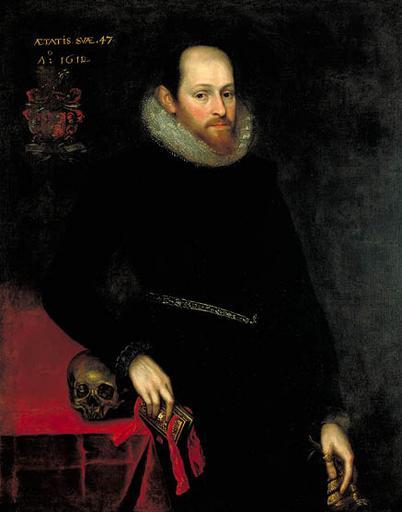MAKE A MEME
View Large Image

| View Original: | Probably_Sir_Hugh_Hamersley,_Lord_Mayor_of_London.jpg (437x556) | |||
| Download: | Original | Medium | Small | Thumb |
| Courtesy of: | www.flickr.com | More Like This | ||
| Keywords: people Sir Hugh Hamersley (6 July 1565 – 19 October 1636) was a 17th century businessman and Lord Mayor of London. Hamersley's family estate was at Pyrton Manor near Oxford, but rose to prominence in London as a businessman. From 1601 he was a member of the Haberdasher's Company, at which he served as Master from 1619-20 and from 1627-8. During the 1620s he was on the board of several merchant companies, including the mercant companies of Russia, the Levant, East India, France, Virginia and Spain. Hamersley also served in political positions, being Sheriff of the City of London in 1619. He was Colonel of the City from 1619 to 1633. After his term as Mayor from 1627-8 he was knighted by King Charles I. In 1634 Hamersley was president of Christ's hospital charitable school. After his death a memorial was erected by his widow in the church of St Andrew Undershaft, London. A painting of Hamersley, known as the Ashbourne portrait, was widely reproduced during the 19th century as a portrayal of William Shakespeare, and it currently hangs in the Folger Shakespeare Library. In 1940 Charles Wisner Barrell examined the portrait using X-ray and infra-red photography, as well as rubbings of the concealed paint on the sitter's thumb ring, and concluded that the painting is a retouched portrait of Edward de Vere, painted by Cornelius Ketel.[1] In 1979, an examination of the portrait by William L. Pressly identified the sitter as Hamersley, stating that the portrait had been retouched to alter Hamersley's age by one year and to paint over Hamersley's coat of arms.[2] The identity of the sitter is, however, still believed to be de Vere by some scholars.[3]In this regard, in 2002, the New York Times reported a claim by Barbara Burris, writing in the newsletter of an Oxfordian group, the Shakespeare Fellowship, "that the fashions the sitter wears in the painting date to about 1580, when Hamersley would have been 15 and Oxford 30, and when Ketel was working in England." Sir Hugh Hamersley (6 July 1565 – 19 October 1636) was a 17th century businessman and Lord Mayor of London. Hamersley's family estate was at Pyrton Manor near Oxford, but rose to prominence in London as a businessman. From 1601 he was a member of the Haberdasher's Company, at which he served as Master from 1619-20 and from 1627-8. During the 1620s he was on the board of several merchant companies, including the mercant companies of Russia, the Levant, East India, France, Virginia and Spain. Hamersley also served in political positions, being Sheriff of the City of London in 1619. He was Colonel of the City from 1619 to 1633. After his term as Mayor from 1627-8 he was knighted by King Charles I. In 1634 Hamersley was president of Christ's hospital charitable school. After his death a memorial was erected by his widow in the church of St Andrew Undershaft, London. A painting of Hamersley, known as the Ashbourne portrait, was widely reproduced during the 19th century as a portrayal of William Shakespeare, and it currently hangs in the Folger Shakespeare Library. In 1940 Charles Wisner Barrell examined the portrait using X-ray and infra-red photography, as well as rubbings of the concealed paint on the sitter's thumb ring, and concluded that the painting is a retouched portrait of Edward de Vere, painted by Cornelius Ketel.[1] In 1979, an examination of the portrait by William L. Pressly identified the sitter as Hamersley, stating that the portrait had been retouched to alter Hamersley's age by one year and to paint over Hamersley's coat of arms.[2] The identity of the sitter is, however, still believed to be de Vere by some scholars.[3]In this regard, in 2002, the New York Times reported a claim by Barbara Burris, writing in the newsletter of an Oxfordian group, the Shakespeare Fellowship, "that the fashions the sitter wears in the painting date to about 1580, when Hamersley would have been 15 and Oxford 30, and when Ketel was working in England." | ||||